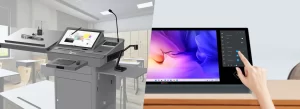Today’s Smart TVs juggle two roles: your entertainment hub and a dynamic business tool. Samsung’s Tizen and LG’s WebOS excel at streaming, gaming, and smart home control—but they also power professional digital signage with Pickcel.
Does Tizen’s SmartThings edge or WebOS’s intuitive design better fit your needs, whether you’re binge-watching Netflix or managing a fleet of signage screens? We compare performance, apps, and integrations to help you decide.
Intro to LG WebOS and Samsung Tizen OS
What is WebOS ?
WebOS is a Linux-based operating system powering LG smart TVs and other connected devices. Originally developed by Palm and later acquired by LG, it offers an intuitive, card-based interface for seamless multitasking and navigation.
Integrated with ThinQ AI, webOS supports voice control, personalized recommendations, and smooth access to streaming apps.
Beyond TVs, webOS extends to LG’s smart signage, projectors, and appliances, reinforcing its role in a connected ecosystem. Known for simplicity and responsiveness, webOS remains a top choice for LG’s smart entertainment experience.
What is Tizen OS ?
Tizen, developed by Samsung and backed by the Linux Foundation, is a versatile open-source operating system powering Samsung’s smart TVs, wearables, and IoT devices.
Samsung’s dominance in the global TV market is largely driven by Tizen’s intuitive interface, which integrates popular streaming services, Samsung TV Plus (free ad-supported content), and AI-driven recommendations via the Universal Guide.
Beyond entertainment, Tizen extends its capabilities to IoT and smart appliances, emphasizing interoperability within Samsung’s ecosystem. Its lightweight architecture ensures fast performance, while its adaptability allows it to power a wide range of connected devices.






